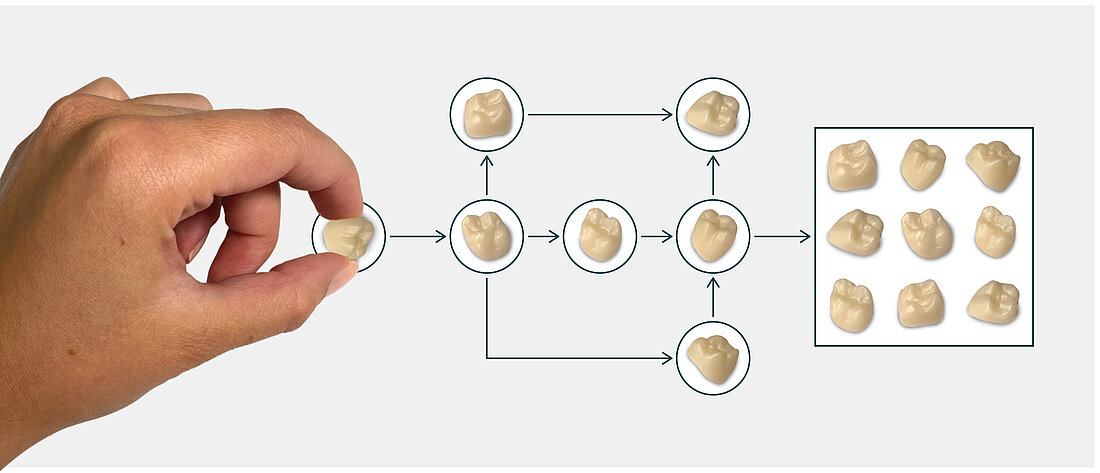Dental digital – the digital 360° workflow in the dental laboratory
To start with, there is no such thing as ONE digital 360° workflow in the dental laboratory. On the one hand, it always depends on the patient case, because every patient is individual and has a wide variety of requirements, and on the other hand, the structures and processes in dental laboratories are not necessarily comparable.
In every work step, a digital dental workflow improves communication between the treating person and the employees in the dental laboratory. A completely digital workflow offers the possibility of tracking the order in every recorded work step and providing information just in time.
In the following sections you will get an overview of how a digital 360° workflow in the dental laboratory could look in detail.
1. Basis of order: oral situation and choice of dental shade
The type of dental care to be commissioned is discussed with the patient. This also includes information about material and tooth shade. In this first step, an image of the oral situation is often created. Among other things, this data forms the basis for a cost estimate. In a digital 360° workflow, this information is already transmitted digitally from the dental practice to the dental laboratory.
Advantage:
The dental laboratory has the option of creating a digital patient case based on this data, creating a cost estimate and sending it digitally to the practice. The digital transmission of the situation and the desired care reduces the risk of misunderstandings to a minimum.
2. Commissioning by sending the intraoral scan
In a digital 360° workflow the impression is taken virtually using an intraoral scanner and this data is transmitted directly to the dental laboratory.
Advantage:
This process happens in real time, saving time and resources. If the scan is too imprecise, the dental laboratory has the opportunity to give direct feedback so that it can be repeated as long as the patient is still with the treating person.
3. Virtual model creation and design of the restoration (CAD)
The patient case created in step one is handed according to the scan data, now flows into capacity planning and is assigned to an employee. The virtual model is created on the basis of the scan and on this basis, taking into account all the information stored in the patient case, the work is designed virtually with the dental CAD software.
Advantage:
The virtual creation of the model, which serves as a working basis for the subsequent virtual design, eliminates errors in relation to the fit of model and framework. Time and resources are also saved in this step, because a time-consuming model scan is no longer necessary at this point.
4. Fabrication of model and framework (CAM)
Model and framework, usually in STL data format, are transmitted to the machines and prepared for production. The data for the model is usually transferred to a 3D printer, the data for the framework - depending on the type and material of the restoration - to milling machines, LaserMelting systems or also to a 3D printer. With dental CAM software, the data is processed in such a way that it is ready for subtractive or additive manufacturing processes.
Advantage:
Thanks to the dental CAD/CAM process, frameworks can be easily reproduced at any time. In addition, you always have the option of outsourcing production in the event of high times or difficult materials that you process yourself but do not use in your dental CAM process (e.g. gold or titanium).
5. Quality Management
Before the framework is fitted to the model and then further processed or elaborated, both components are checked for quality, for example by comparing them with the virtual data. At this point, the order and patient data are usually checked again.
Advantage:
At this point, the digital dental workflow offers the opportunity to compare the designed data files with the produced component and to reconcile them with the situation and the information provided.
6. Order tracking until delivery in practice
This part of the manufacturing process is analog. The patient work is accompanied at all times with the digital routing slip, so that it can be checked at any time whether the order is in time or on which workbench the order is currently located. After the final check, the patient work is sent for dispatch.
Advantage:
At any point in time, a statement can be made as to where the order is and whether it is on time. Depending on the progress, you can intervene in the process and make changes to the plan if necessary.
CONCLUSION
The aim of a digital 360° workflow is to support you in your everyday dental laboratory work, to facilitate communication between practitioners and dental technicians, as well as between the departments of a dental laboratory, and thus to prevent and counteract misunderstandings. The resources that are freed up give you the opportunity to invest your time in more intensive advice, technical discussions, familiarization with new technologies and more value-adding tasks, such as ceramic veneers.
Do you have questions about how to integrate outsourcing to a manufacturing center into your digital 360° workflow, or would you like to speak to one of our experts on other topics related to digitalization in your dental laboratory? Contact us. Our experts will be glad to advise you!
